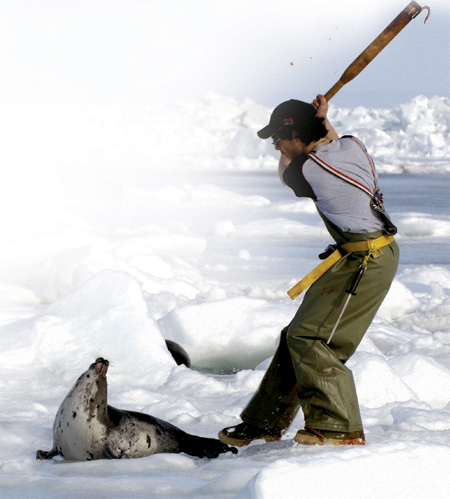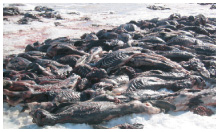Making a killing
Updated: 2011-01-21 08:10
By Hazel Parry(HK Edition)
|
|||||||
|
Two seals lie dying on the ice waiting to be skinned. Humane Society / Red Door News |
|
A sealer in the Canadian seal hunt stands poised to kill with a hakapik. B Skerry / Humane Society / Red Door News |
Campaigners are hoping Hong Kong will lead the way in banning seal products following a deal by Canada to export seal meat to China, writes Hazel Parry.
The package on the bottles of Canadian Seal Oil on sale at HK$388 in Watsons shows a pleasant picture of two healthy-looking seals with shiny, sleek coats. The words that accompany this image promise the Omega 3 oils obtained from seal oil bring health benefits essential for the heart and brain.
But the real picture behind this product on sale in Hong Kong is much less appealing, according to Rebecca Aldworth of the Humane Society International, and to prove it she displays a series of haunting images.
The photographs, all taken during the annual seal hunt in Canada, show where this oil came from and the inhumanity involved to harvest it, she claims.
Some depict hunters in the process of killing seals, their hands poised to deliver a fatal blow to the animal's skull with a hakapik - a metal-spiked club. Others show seals dead and dying, their blood staining the white of the ice flows, and being tossed on to pile of carcasses.
According to Aldworth, the seal oil supplements on sale in Watsons Hong Kong are one of the products of a cruel Canadian government-backed seal hunt which the Humane Society International and other animal welfare groups have been campaigning to bring to an end for decades.
"It's an annual slaughter that causes extreme suffering to defenseless baby seals," she says.
|
Bodies of the skinned seals are sometimes left to rot, says anti-seal hunt campaigners. Humane Society / Red Door News |
"Each year, observers document horrendous cruelty at the slaughter, including baby seals impaled on metal hooks and dragged across the ice and cut open while conscious, while wounded seals are left to suffer in agony."
The hunt she is referring to takes place annually on the ice flows of the north Atlantic off the coast of Canada and results in the killing of thousands of seals every year.
The furs shipped 170 miles to the Canadian east coast are sold for between HK$120 and HK$400 each to make trimmings on garments, coats and slippers.
Their blubber, extracted from under the skin, is less lucrative bringing in only HK$10 to HK$20 per kilo. It is the source of the seal oil used in Omega 3 health supplements like those on sale in Watsons, while a proportion of the meat is cured for human consumption.
Aldworth believes none of these products should be on sale anywhere in the world including Asia and stopped off in Hong Kong recently on a visit to the mainland to get the message across that buying seal products - whether fur, oil or meat - helps sustain the hunt.
It's a message which she says has been made more crucial by two recent events: the 2009 banning of seal product trade in Europe - which previously accounted for one third of Canadian seal exports - and the announcement earlier this month of an arrangement between Canada and China to export seal meat for human consumption to the mainland.
The first of these events, Aldworth says, caused the prices of seal skins to crash and forced the Canadian seal industry to look elsewhere for seal products. The second is proof that it believes it has found its market in Asia, specifically China.
"Canada's two largest trading partners, the United States and European Union, have already banned seal product trade, and many other nations are in the process of implementing their own bans. Which is why Southeast Asia is the new focus for Canada's seal product marketing," said Aldworth.
Hong Kong itself is not a big market for seal products. In 2006, the global market value of seal pelts amounted to around HK$100 million for Canada, according to its government statistics. Of this one third, worth around HK$32.2 million, went to Europe.
Figures supplied by the Agriculture and Fisheries Department, show Hong Kong imported 6,110 seal skin pieces in 2009, compared with 1,470 in 2008 and 772 in 2008. The amount of seal product imports, including body parts, stayed roughly steady during the same period at about 300 kilograms each year.
Canadian government statistics put the value of seal fur exports to Hong Kong at HK$776,000 in 2006, with seal oil at HK$469,000.
However the mainland market is much higher at HK$5.7 million for seal fur and HK$9.9 million for oil.
Aldworth fears with the seal meat agreement with China in place, the value of seal products will rise enough to help the industry rebound from the blow dealt by the European Union ban, which in turn will sustain the annual hunt.
How much China will be worth exactly to the seal industry is uncertain but Canadian Minister of Fisheries and Oceans Gail Shea appeared confident at the recent visit to Beijing where she finalized the cooperative arrangement on seal meat.
"Canada is a leader in the production of high quality, safe, fresh and nutritious and sustainable fish and seafood," said Shea, "China is the world's largest consumer of fish and seafood. It is a market that represents great prospects for Canadian harvesters and processors and great growth potential for our exports."
To Aldworth, the agreement gives permission for Canada to "dump products of cruelty the rest of the world has rejected on China".
"The seal industry has been dramatically weakened by the loss of the European market. The government can go two ways: They can invest funds to buy out the industry and to develop economic alternatives for the people involved," she said.
"Or they can use their funds to try and develop markets in Asia. We need them to go with former approach and the only way we can do them is show them Asian markets are not secure and people here feel just as strongly that they don't want to participate in this industry."
Hong Kong can play a pivotal role in this, she says, and banning trade in Hong Kong would not only close the market here but could have a knock-on effect on the mainland and in Asia and send a clear message to the Canadian government.
"Our concern is that Hong Kong is a trading point, a gateway for these products to the mainland," she said. "With enough subsidies these markets have the potential to become huge and we are trying to stop it before it takes off."
Her views on the cruelty of the hunt are supported by the Hong Kong Society for the Prevention of Cruelty to Animals (SPCA) which two years ago launched its own campaign to try to persuade the Hong Kong government to stop the import of any seal product from Canada.
The society appointed actress Karen Mok as their campaign ambassador and in spring 2009 she flew out to ice flows to see the seal populations herself - a trip she described as like nothing she had experienced before.
The SPCA has created an online petition which has so far attracted more than 8,000 signatures, just a fraction of the 700,000 signatures it hopes to collect to persuade lawmakers to follow the EU's example.
SPCA executive director Sandy Macalister said although the hunt took part on a different side of the world, it was a matter of concern here because seal products were on sale in Hong Kong and that the society felt it had a responsibility to let the public know the facts.
"We hope Hong Kong is not playing a pivotal role in keeping the slaughter alive and facilitating the transfer of this product (seal meat) into the mainland," he said.
The Canadian government did not respond to emailed question from China Daily but the website of the Department of Fisheries and Oceans devotes much space to dispelling the "myths" surrounding the annual hunt.
It insists the hunt is not cruel and that independent studies had shown methods used, including the hakapik, to be as humane, and often more humane, than those in commercial slaughter houses.
It says its system of setting a yearly quota on the number of seals killed keeps the population of harp seals, not an endangered species, at a healthy level at 6.9 million, three times the population of 1970.
It claims 60 percent of Canadians are in favor of a responsible hunt and that about 35 percent of the annual income of sealers in small coastal communities came from the seal hunt and it was also an important source of income to the native Inuits.
These are all points disputed by Aldworth and the Humane Society International which claims the hunt is heavily subsidized at a cost to taxpayers, brings little to the economy and that most Canadians are opposed to the industry.
Approximately 67,000 seals were killed in 2010, much lower than the 220,000 deaths in previous years. The quota for the 2011 hunt due to start in weeks has not yet been announced. Whether the new deal with China and the promise of a new market will push the death toll higher this year remains to be seen.
What is clear, says Aldworth, is that the campaign in Hong Kong is now more important than ever.
"The government of China may currently be allowing Canada to ship seal products to China, but the decision as to whether those products will be marketed lies solely with Chinese businesses and the public," she said.
"If Asian businesses and consumers join those in North America and Europe in refusing to trade in seal products, there will be no markets left for the sealing industry, and this abhorrent slaughter of baby seals will finally end.
"By choosing not to consume the products of this cruel, globally condemned slaughter, the people of Hong Kong can directly help bring it to an end. We know they are caring and responsible and that they will not want to play any part in perpetuating this cruel slaughter."
(HK Edition 01/21/2011 page4)


